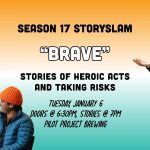Arts & Culture
White Christmas
Snow fell several times, including over the audience, during The Skylight’s seasonal production of Irving Berlin’s White Christmas Saturday night. The perennial favorite – which opened to a dusting of real snow in the city on Thanksgiving weekend – is filled with the Irving Berlin songs that made and continue to make memories during the holidays. This story surrounds two army veterans who become Broadway stars and rescue their old general’s failing Vermont ski inn. Along the way, the friends find romance with a pair of entertaining sisters and create a few surprises in this adapted musical setting. With well-known Milwaukee musical director Richard Carsey and choreographer Pam Kriger at helm, the classic 1954 film comes to life on the Cabot Stage. The score provides plenty of song and dance numbers the audience will enthusiastically enjoy, including less-remembered melodies like “I Love a Piano” and “Falling Out of Love Can Be Fun.” While reenacting the legendary performances of Bing Crosby, Danny Kaye, and Rosemary Clooney might be intimidating, the lead performers carry these roles with a chemistry that builds throughout the first scenes. Norman Moses as Bill Wallace and Branch Woodman as Phil Davis are at ease with these iconic characters, and the delightful dancing of Rebekah Jacobs as Judy Haynes along with the outstanding voice of Melinda Pfundstein as Betty Haynes gives enduring charm to such ever-familiar numbers as “Sisters, Sisters.” This multi-talented team is surrounded by a handsome, capable cast (with innovative performances by Brianna Zawada as the young granddaughter Susan and Rhonda Rae Busch as concierge Martha Watson) and supported with live orchestrations and sparkling 50’s costumes. Inside the Columbia Inn, during the final scene, the cast, cloaked in red velvet and snow-white fur, sings the title song – one of the most popular lyrics in the history of music – and glides the audience into the Christmas season. Giving emotional weight to the storyline, White Christmas is dedicated to several important Milwaukee theater personnel who passed away this year, including Montgomery Davis and Skylight costume designer Jeffrey Olson. Berlin’s tribute to family, friendship, and dreams of home over the holidays is heartwarming entertainment, evoking the simple longing and joy of being with loved ones in less complicated times and reminding is that loving and being loved are the best gifts to give in celebration of the season. VS White Christmas plays at the Cabot Theatre through December 31. Tickets are available by calling 414-291-7800, or visit skylightopera.com.
Nov 28th, 2007 by Peggy Sue Dunigan12 Days – A Milwaukee Christmas
How many teachers inspire and believe in their young students? First Stages Children’s Theater musical play, 12 Days – A Milwaukee Christmas, is the adapted true story of Miss Emily Brown, a Downer College Professor whose Christmas theatrical productions became legendary in Milwaukee at the turn of the century. First Stage presents this holiday offering as a world premiere, written by Playwright-In-Residence James DeVita. DeVita is well-known to Milwaukee and Madison audiences as a core company member at the American Player’s Theater in Spring Green and, more recently, as the author of last year’s one-man show, Dickens In America, staged by Milwaukee Chamber Theatre. This children’s play reprises his admiration for Dickens as he incorporates elements of the English author’s stories and words from the “The Twelve Days of Christmas,” which Emily Brown is credited with bringing to America from England. Money and supplies are scarce in 1917, during World War I, and Emily Brown, now a grade-school teacher, struggles to stage her Christmas play. The Scrooge-like principal, Mrs. Crudgens, orders the pageant cancelled, but the students heed Miss Brown’s words: “In this class, as in life, an effort is required.” They go caroling to earn the funds, and in the end, in true Dickensian fashion, minds are changed, hearts are won and everyone enjoys the final presentation. Traditional carols and falling snow sprinkle this First Stage production with charm. Sarah Day as Emily Brown brings energy to the stage throughout the 90 minutes, and her chemistry with Bo Johnson, playing Polish-American school employee Mr. Horace, adds a touch of tenderness to the slightly contrived plot. The Pear Cast, one of two sets of child actors alternating throughout the run, contributed ample talent to the humorous and light-hearted performance on opening night. An interesting historical set and period costumes accent the production. In the final scene, the students wear “homemade” costumes like plum pudding and buttered dinner rolls, which delighted all ages in the audience as they finished with a sing-along of the title carol. Ultimately the production offers some important ideas for discussion throughout this festive season: often life requires an effort, an imaginative effort, especially when difficulties arise. As Miss Brown quotes from Dickens to her students, trying to encourage them to see beyond their own circumstances, she says, “Without imagination, there can be no compassion.” First Stage’s 12 Days – A Milwaukee Christmas uses both imagination and effort to tell this family-friendly story of Christmas hope and how one person’s efforts can change lives in the smallest of ways. Perhaps with true Dickens conviction, adults and children will remember to make these compassionate efforts throughout the holiday season. And believe – as Mr. Horace and Emily Brown believe – that “Christmas is not complicated. Christmas is Christmas. Heaven bless us!” First Stage Children’s Theater presents 12 Days – A Milwaukee Christmas in the Todd Wehr Theater at the Marcus Center for the Performing Arts through December 24. For information: 414.273.7206
Nov 28th, 2007 by Peggy Sue DuniganGREETINGS!
By Tracy Doyle If you’re looking for a little holiday fun that isn’t your 234th viewing of A Christmas Carol, The Nutcracker, or It’s a Wonderful Life, head to the Off-Broadway Theatre for Next Act’s delightful presentation of Tom Dudzick’s GREETINGS! This holiday favorite tells the story of the Gorski family on Christmas Eve as they entertain two very unexpected guests. Andy Gorski, who has moved from his small town to the big city, returns home for Christmas with his new girlfriend, Randi Stein. Almost immediately upon arrival, Randi, an atheistic Jew, and the Gorskis, devoutly Catholic, start to argue about religion. Sparks fly and the holiday seems to be ruined until Andy’s younger mentally disabled brother Mickey saves the day. As the evening progresses, old beliefs are challenged, new beliefs are forged, and the family is drawn together by the arrival of a second incredible holiday guest. Although the script is heavy handed at times and each plot line hammers the same idea over and over, the loving spirit of the play shines through. The cast of GREETINGS! is stellar and enjoyable to watch. David Cecsarini and Debra Babich are very believable as Mr. and Mrs. Gorski; they bicker and jab as only a long-married couple can, yet they are never stale or stereotypical. Often I found myself wondering how the heck my grandparents had found their way onto the stage. Elizabeth Audley (Randi Stein) and Eddie Collins (Andy Gorski) were also quite pleasant, but Marcus Truschinski (Mickey Gorski) stole the show with his spectacular portrayal of a mentally disabled twenty-something. Truschinski used his entire body, from every twitching muscle in his face to every awkward twist of his ankle, to create an entirely believable, never politically incorrect, character. He was funny, yet serious – definitely the star on the top of this production’s Christmas tree. It all comes together for an unforgettable night of great theatre – if you see GREETINGS!, be prepared to laugh and open your heart and mind a little to let in the true spirit of the holidays. GREETINGS! runs through Decmber16 at the Off-Broadway Theatre. Tickets can be purchased in advance by calling the ticket office at 414-278-0765 or online at www.nextact.org.
Nov 26th, 2007 by Vital ArchivesCarolin’ Carolynne’s Comin’ To Town
By Jill Gillmer Is it just me, or does the title Carolin’ Carolynne splashed across a red-and-green banner suggest that this holiday revue might include a few Christmas carols? This was how I convinced my elderly aunt and mother to accompany me to the performance. When I found myself waiting for the first carol nearly an hour into the show, I realized that Carolynne was going to make a liar out of me, despite the creative arrangement of Silent Night (with different lyrics) and a few bars of one or two other Christmas favorites sprinkled between non-holiday songs. But the “rollicking tunes” featured in the Stackner Cabaret’s holiday production were more appropriate for a Holiday Booze Cruise – I mean Blues Cruise – than a Sunday afternoon with conservative relatives. Once I got past the disappointment of a carol-free performance, though, I was able to enjoy the ride. Billed as a vacation for those suffering from holiday-related depression, Carolynne Warren’s one-woman show features a series of wacky characters gently coaxing the audience out of its melancholy with a charming array of songs and skits. Its success isn’t due to the humor in the writing – indeed, much of the comedy borders on slapstick. Nor is it because of Ms. Warren’s average singing voice. Carolynne Warren is a hit with audiences because of the warmth and compassion she obviously feels for the characters she’s penned. One stand-out is a mermaid/Genie in a Bottle/vixen who addresses the lovelorn souls who unfortunately sought her advice. In another scene, a therapist enthusiastically espouses the virtues of anti-depressants over psycho-therapy. As a writer, Ms. Warren has a special gift for tapping the humor and sadness that coexist in the human heart. And it’s hard not to identify with at least one or two of the pathetic ballads she croons as the potential Soundtrack of Your Life. Ms. Warren’s piano accompanist, the immensely talented William Knowles, adds a calming balance to her frenetic energy. The many costume changes and creatively-rewritten songs keep the pace lively. All in all, it’s not a bad way to cure your holiday malaise. VS Carolin’ Carrolynne’s Comin’ to Town runs through January 6 at the Stackner Cabaret. For tickets and information, contact (414) 224-9490 or visit www.milwaukeerep.com.
Nov 26th, 2007 by Vital ArchivesTrying
Trying, written by Joanna McClellan Glass, was inspired by the Canadian playwright’s relationship with Judge Francis Biddle – private secretary to Supreme Court Justice Oliver Wendell Holmes, Attorney General under President Franklin D. Roosevelt and the primary American judge at the Nuremberg Trials – in his last declining year. The Milwaukee Chamber Theater appropriately places this contemplative show at the mid-point of its season; it regards both a cold seasonal time and the final season of a long life. And while neither riveting drama nor sparkling comedy dominates this two-person play, it seemed a crowd-pleaser for the history buffs and older audience members alike. Biddle is performed deftly by veteran actor Richard Halverson. As many of us with aging grandparents know, it is painful, physically and psychically, to face failing health with so much unfinished business. Halverson dodders about the stage, wringing his arthritic hands and falling into fogs. By contrast, MCT newcomer Molly Rhode portrays Sarah Schorr, a polite Saskatoon prairie girl who has followed her new husband to the American East Coast and seeks part-time work as secretary to the irascible judge. Rhode serves well enough as author Glass’s character double, but the role as it’s written or as it’s played lacks something until the final act, when Schorr transforms. Perhaps it is because of the character’s context in history (the play is set in 1967; Glass tried Trying as a one-act play in 1971 but didn’t finish it until 2004) that the neophyte secretary isn’t played with more confidence or will. A forward-era character wouldn’t have put up with the irritating elderly man’s demands, no matter his historical importance. Certainly a woman of the progressive late sixties, though, could have given Biddle a fighting spirit rather than waiting a year to gain his trust. Then again, perhaps the difficulty lies in perceiving Biddle as having any menace or domination at his age. It’s easy to understand why his previous secretaries quit rather than take a stand. He doesn’t seem worth fighting over. The staging in the intimate Studio Theater was clear and the delivery handled well given the script’s complexity and slower pace. Occasionally, references don’t hold up to modern times any more than a biting satire from Will Rogers might, but they serve well enough as atmosphere. The play at its most interesting lets us watch as the old man copes with his failing mind and body to the point of tearful frustration. At one point, he bemoans that he “may be an invalid, but he’s not yet in-valid.” There’s a subplot about Schorr’s determination to be a writer that is missing from this particular production, which may have made balanced the roles more equally. Otherwise it was a thoughtful, quiet play that braces us for the winter and prepares us for the re-birth of spring. VS Trying continues now through Dec. 16 at the Milwaukee Chamber Theater, 158 North Broadway in the Third Ward; 414-291-7800, www.chamber-theater.com. Pre- and post-talkback discussions with the cast and director […]
Nov 19th, 2007 by Brian JacobsonMichael Chabon at the Jewish Community Center’s Book and Culture Fair
Michael Chabon, author of Wonder Boys, 2001 Pulitzer-winner Adventures of Kavalier and Klay, acclaimed novella The Final Solution and most recently Gentlemen on the Road (a serialized story written for New York Times Magazine in 2007), was arguably the biggest-name Jewish writer out of many to appear at the JCC’s Book and Culture Fair in Whitefish Bay this November (see milwaukeejewish.org for details on remaining dates). The 44-year-old California resident and frequent traveler drew a few hundred attendees, most likely attending to hear him read, as advertised, from his May-released potboiler The Yiddish Policeman’s Union, which has been hailed as his best to date – and perhaps most controversial. But instead the soft-spoken and blue-eyed man in a tweed jacket pulled a sheaf of papers from a folder and began to read loosely from a prepared speech. Instead, Chabon appeared to be seizing the chance to explain his tale to a mostly-Jewish audience. He defended a misunderstood essay he penned which appeared in the June 1997 issue of Civilization Magazine after Yiddish-speaking clubs and stalwarts took him to task and deftly (but not dismissively) handled audience questions about his “bad” characters in Yiddish Policeman’s Union, who appear to be Orthodox Jews. The evening remained genial and gracious throughout. Chabon didn’t stray much from his early critical image as “a nice Jewish boy, so eager to please” as he relays to the crowd. But he also admits that his work remains provocative because of the equally subversive “devil inside [himself]” that writes things you aren’t supposed to talk about. Yiddish Policeman’s Union imagines a Jewish province founded for refugees of World War II and eventually the 1948 Arab-Israeli Conflict. Just as various countries such as Uganda or Argentina were proposed by some early Zionists, then-Secretary of the Interior Harold Ickes convinces Congress in this alternate universe to lend the panhandle of Alaskan Territories to the troubled population. Chabon’s town of Sitka, Alaska is a cold, noir location, like something out of Raymond Chandler story. A long-time fan of genre fiction like mysteries, sci-fi, and comic books, Chabon has consistently created deep, hard-hitting characters. But while his prose and craft was praised when the book was first released, it was also dogged for its imagined proposal and treatment of characters. Later Chabon stated that he wanted “to create a home in his imagination,” and that while he once shunned his background, he now seeks ways to explore and cherish it. Perhaps because of the setting, the evening’s talk was dominated with questions about Yiddish, Jewish statehood, and the culture in general. Any deep questions about character development, plot, and the writing process were relegated to short, superficial moments. It may be that the era of small talks with big authors on book tours has led to expectations of intimacy and thoroughness in discussion, but in this instance, just spending some time was fair enough. VS Michael Chabon’s Yiddish Policeman’s Union and Gentlemen of the Road are currently on sale at area booksellers […]
Nov 19th, 2007 by Brian JacobsonIndian Blood
By Carrie Beilke Without awkward family gatherings, the holidays would just be a time to eat turkey and spend too much time at the mall. The Boulevard Theater’s presentation of A.R. Gurney’s Indian Blood is an intimate peek into one such Christmas, with plenty of dysfunctional family members, arguments and wholesome helpings of Americana to go around. This memory play, set in the late 1940s, is sparsely dressed with plain wooden chairs. There are no other props and actions are mimed. To keep things light- hearted and remind us of the Christmas spirit, carols sung by Caitlin Kujawski cue the scene changes. High school student Eddie (played by actual high school student Joseph Redemann) does heavy lifting as both the narrator of the holiday memory and an instigator of trouble. Eddie’s been kicked out of school, blaming his “Indian Blood,” and though his parents aren’t particularly happy, they try to smooth things over for the Christmas dinner at Grandmother’s. Eddie’s mother, played by Maureen Dornemann, is serene as the out-of-place in-law, kindly reminding her son that there are already plenty of old conflicts at the table. There’s another twist to this year’s celebration: in a display of charity, Grandmother invites Eddie’s weasel-y cousin Lambert (a pleasantly annoying Hugh Blewett). Lambert isn’t interested in charity, though, and would prefer to use the opportunity to take Eddie down. It may look like an innocent game of musical chairs, but to the boys, it is a battle. These sorts of skirmishes, which pop up all over the drama, are welcome respite from some drearier social commentary – as you might expect from a sketch of the last century, the story at times wavers into confusion as it pokes fun at high society, WASP family values and the decline of the city of Buffalo. Overall, though, it’s a fun show, so watch your table manners, don’t fill up on the bread, and save room for the homemade pumpkin pie served at intermission. VS Indian Blood runs at the Boulevard from November 14th through December 2nd. Call 414-744-5757 for ticket information.
Nov 19th, 2007 by Vital ArchivesTime Machine
Three days after listening to Russell Bowman’s lecture at the Milwaukee Art Museum, I drove with a friend to re-visit the John Michael Kohler Arts Center (JMKAC) in Sheboygan. Bowman, the former Executive Director of MAM, spoke so eloquently and in-depth about when and how MAM’s “folk art” collection came to fruition; it seemed the perfect excuse to take another look at JMKAC’s collection of art, specifically Sublime Spaces & Visionary Worlds: Built Environments of Vernacular Art, which runs until January 2008. Let’s forget about labels for the time being. Whether you choose to refer to work produced by self-taught artists as “folk,” “outsider,” or “visionary,” bear in mind that the distinctions overlap more often than they divide. Blurred boundaries can be a good thing. Sunday, November 11 may not have been the best day to travel north, though my friend and I fortunately dodged the crowds rushing to Lambeau in massive vehicles bound for the Packer-Vikings game. The upside was finding JMKAC virtually empty, so we more or less had the glorious place to ourselves. There is no admission fee and on that day, parking was certainly not a problem. My travel companion, self-taught artist Jilan Glynn, lives in a tiny Walker’s Point home resembling an art installation. She uses a cane to get around these days, but not just any old cane. She made hers, and it was a perfect accessory for a perfect day. Walking through the galleries is somewhat akin to entering a voluminous tent where a circus is underway. Step right up, folks. Don’t be afraid. What you are about to see is not an illusion. With twenty-one artists represented, artists from here, there, and everywhere, you’d expect to feel claustrophobic, because many of the artists produced massive figurative works originally intended for “natural” environments such as yards and wide open spaces. Thanks to the excellence of JMKAC’s curatorial staff, though, each artist’s work clearly has its own space and never seems isolated. Nothing is crowded or crammed awkwardly. The interior architecture embraces the collection. Intricate, concrete constructions lead to stately clusters of figures fashioned from fabrics and clay before giving way to the light and airy wire fantasies of the wildly prolific Emery Blagdon. Standing there, I wondered what it might be like to live inside of a delicate web spun by the mind of an artist. My friend remarked that she wished there was a fan blowing nearby, so she could see the slender objects move. When we looked skyward to pieces suspended from the ceiling, indeed, some were moving, but ever so gently, in the whispering air currents. A fan would have been a travesty! In his lecture, Russell Bowman remarked that sometimes when the work of self-taught artists is removed from its natural environment to an institutionalized setting, it acquires another meaning. I agree with his statement, but such is not the case with this outstanding exhibit, which avoids being “precious.” At the risk of sentimentalizing the entire experience, it did […]
Nov 16th, 2007 by Judith Ann MoriartyThe song remains the same?
By Ellen Burmeister Once regarded as the epitome of the excesses of the 1970s rock landscape, Led Zeppelin is currently undergoing a revival of sorts, which is expected to culminate in a much-heralded reunion concert in London this December. For those of us who can’t book a flight to Heathrow, an admirable substitute came to the Riverside Theater November 9 as a 50-piece subset of the Milwaukee Symphony Orchestra. Under the direction of composer/arranger Brent Havens, they presented “The Music of Led Zeppelin”, a “rock symphony” of fifteen of the band’s best loved tunes. Notching up the rock chops of the ensemble were – most notably – vocalist Randy Jackson, guitarist George Cintron, electric violinist Allegra, and drummer Powell Randolph (granting the crowd a sampling of a truly Bonham-worthy solo on “Moby Dick”). While no one can match the vocal acrobatics and writhing tight-pants sensuality of Robert Plant at his peak, Randy Jackson proved that the art of rock vocals is a worthy equivalent to that of any other highly trained vocal discipline, especially when backed by a professional ensemble. Almost academic in his approach, Jackson gave a thrilling “reading” of the varied styles in the Led Zepplin playbook – classic rock, blues, and even English folk – and played some great acoustic guitar as well. Kudos to guitarist Cintron and violinist Allegra as well. Jimmy Page’s fabulously inventive and complex riffs got their due props thanks to this unique splitting and doubling of his musical vision among these two talented musicians, particularly on “Black Dog” and “Heartbreaker.” And – despite the challenges of competing with an amplified bass line that approached “11” – the Milwaukee Symphony Orchestra brought a rich timbre to the tracks. Subtle changes such as the addition of an oboe to the flute meanderings on “Stairway to Heaven” or the lush backup lines on “In the Evening” reminded the appreciative audience of the beauties hidden in tracks so often taken for granted. And of course, “Kashmir” never sounded more exotic or epic as when a full orchestra takes on its throbbing rhythm and evocative harmonics. The capacity crowd was visibly proud of its hometown orchestra (a terrific outreach project for the MSO if there ever was one) and participated wholeheartedly in every opportunity for interaction that arose. By the time “Stairway” reared its ubiquitous head (complete with the rarely heard guitar and vocal prelude), there was an overwhelming sense of satisfaction in the crowd. No one was alarmed by bustles in their hedgerows. VS
Nov 12th, 2007 by Vital ArchivesThe 25th Annual Putnam County Spelling Bee
The spelling bee dates back to the early nineteenth century, and what may have started as a celebration of literacy in a largely agrarian nation has become a common feature of childhood culture familiar to people all over the country. One slice of Americana meets another in The 25th Annual Putnam County Spelling Bee — a musical about the fictitious bee of an insular county that could be anywhere in the country. The musical, which opened at the Marcus Center this past Tuesday and runs throughout the week, is patterned after an actual spelling bee. There are grade school-style standing displays in the lobby and a desk for anyone in the audience who wants to sign up for the bee. At the beginning of the show, half a dozen audience members are called to the stage to compete. The show is performed without intermission and, strangely enough for a musical, with relatively little singing. Songs are short, inconsequential and as memorable as a fifteen-second television commercial. The result is a passably enjoyable comedy full of spelling-bee jokes and deft language-play that would be great if it weren’t for all those songs breaking the pace of the laughs. While music drags the production in numerous places, Spelling Bee is entertaining as a character comedy. The spellers are diverse: Logainne Schwartzandgrubenierre (Dana Steingold), the precocious ultra-liberal daughter of two gay dads; William Barfee (Eric Roediger) an awkward kid with a unique spelling technique; Olive Ostrovsky (Vanessa Ray ), the child of distant parents; eccentric Leaf Coneybear (Andrew Keenan-Bolger), whose spelling abilities seem to come from nowhere; multi-talented ultra-perfectionist Marcy Park (Katie Boren) and sexually frustrated Boy Scout Chip Tolentino (Justin Keyes). James Kall has a brilliant sense of comic delivery as Vice Principal Douglas Panch, who officiates the bee with former champion Rona Lisa Peretti (Roberta Duchak). The touring production uses the old trick of dropping local references like Brett Favre and Brady Street. Still, nothing can top the craziness of inviting actual audience members to compete in the bee. It’s staged – the audience members are gone by the time the first couple of characters are eliminated – although on opening night, one woman didn’t get cut as expected, even managing to spell a word that had been entirely fabricated for the musical. Her turn came up again immediately, and she politely misspelled a much longer word. A show that so clearly welcomes this kind of controlled audience participation has a clever charm to it. VS The 25th Annual Putnam County Spelling Bee runs through November 11th at the Marcus Center. Tickets can be purchased in advance by calling the box office at 414-273-7206 or online at www.marcuscenter.org. December 11 – 16, the touring company makes its way to the Fox Cities PAC in Appleton. For more info, visit www.foxcitiespac.com
Nov 8th, 2007 by Russ BickerstaffAs You Like It
By Tracy Doyle As You Like It, one of William Shakespeare’s most popular pastoral comedies, has long sparked debates over its merits. Wisconsin Lutheran College’s production is no exception. The play is set in what is most likely France and opens after Fredericke, the younger brother of the reigning duke, has usurped the dukedom and banished his brother. The action centers on the rightful duke’s daughter, Rosalind, her eventual flight of the dukedom and her convoluted relationship with Orlando, the youngest of three sons of the late Sir Rowland deBoys. Like many Shakespearian works, there are endless love intrigues and twisted relationships; basically, Rosalind disguises herself as a man and playacts with Orlando, who thinks she is “Ganymede.” Ganymede tries to free Orlando of his love for Rosalind by pretending that he is Rosalind (of course, he/she is) and teaching Orlando about the perils of loving a finicky woman. Everything works out in the end and weddings abound, and generally, it could be quite the amusing romp in the woods. However, Wisconsin Lutheran College’s production takes away some of the value of this piece. Much of the acting is unbelievable and childish. The dialogue is rushed through like an unwanted chore, and even the plot is obscured by silly, show-stealing business. Critics of past productions of As You Like It have wondered whether it is a serious work with intrinsic literary value or a mere entertainment. In this production, it is impossible to critique the script itself as much of the dialogue was incomprehensible. Judging the entertainment value of the show is equally challenging. Because extraneous stunts were included in nearly every scene between Rosalind/Ganymede and Orlando, serious viewers are constantly distracted from the story and unable to lose themselves in the fun. Whether this was intended to divert attention from the obvious homosexual overtones of the play or to “pep up” a script the director found too boring on its own is unclear. But as much as this reviewer disliked the performance, the entire cast and audience seemed to be having the time of their lives. The young faces of the Shakespearian troupe gleamed with constant excitement, and the audience reacted strongly, laughing, oohing, and ahhing at their loved ones on stage. Both the adorable Aaron Taylor Klein (Orlando) and the charming Allyss Elaine Martin (Rosalind) have a very likeable energy with the promise of good performances to come. However, if you’re looking for good Shakespearian theatre, keep looking, because this production is definitely not as you like it. Wisconsin Lutheran College’s production of As You Like It runs through November 10. For more info, visit http://www.wlc.edu/arts/
Nov 7th, 2007 by Vital ArchivesIan Ball
Fans of Southport, England’s Gomez have long realized that with three songwriters in the band, there was bound to be a bit of venturing into solo-land, for true-blue songwriters can only collaborate and play nice for so long. Ian Ball has no desire to see his outfit disband, but is keen to try some orchestrations of his own, which are in turn are subtly lovely, genuine, organic and pleasing in their simplicity. It’s fair to call Who Goes There “piano-driven,” but don’t let that lead you to think this is a typical boy-and-his-piano heartstring-tugger. Rather, Ball has mastered an uncanny knack to make the absence of guitar largely unnoticeable. Instead, he magically manages to serve up a heavy rotation of a crunchy Fender Rhodes, mellow acoustic piano, electronic loopery and glass-clear glockenspiels that override the soft strummings of acoustic guitar in a playful way, lending a fresh sound to songs of love and its trials, which are lyrically a little cheeky, but never campy. Ball even manages to make getting high from enough drugs to tranquilize an elephant (“The Elephant Pharmacy”) sound charming. Ball’s skills as a solo artist lie in his ability to bring living-room ballads uncannily within reach, despite his intensely personal storytelling style. From the introspective, self-soothing opener “Sweet Sweet Sleep” to the bouncy “Automatic Message” and whimsical “When We Were Cool,” Ball doesn’t get in anyone’s face – just garners slow, but solid, appreciation. VS
Nov 5th, 2007 by Erin Wolf



















